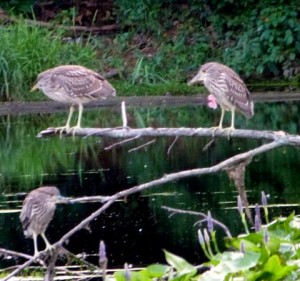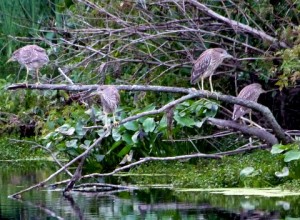 In the warm light of an early August evening, I see what I had hoped for: a night heron, perched on a dead branch hanging out over York Pond, motionless, staring at the water, waiting for fish. With its short legs and stocky body, it appears neckless as it perches, hunched over the water, utterly lacking the grace of its relatives, day herons and egrets.
In the warm light of an early August evening, I see what I had hoped for: a night heron, perched on a dead branch hanging out over York Pond, motionless, staring at the water, waiting for fish. With its short legs and stocky body, it appears neckless as it perches, hunched over the water, utterly lacking the grace of its relatives, day herons and egrets.
As I watch, another flies in, then two more, all clustering together on the same fallen tree branch. They’re all juveniles, wearing the brown and white plumage for their first three years, still far from the elegant grey and black of their elders. When they mature, even their eyes will change color, from orange to a startling bright red.
 Night herons are not an uncommon sight in New England near pond edges, marshes, and rivers, but it is thrilling to see them in our urban setting. These young herons hatched here at York Pond in Providence beside the Seekonk River in a rough, carelessly made nest, possibly in a tree nearby. Night herons fish from dusk to dawn, when they return to sleep in their rookery in the trees, while the other herons and egrets take up daytime fishing.
Night herons are not an uncommon sight in New England near pond edges, marshes, and rivers, but it is thrilling to see them in our urban setting. These young herons hatched here at York Pond in Providence beside the Seekonk River in a rough, carelessly made nest, possibly in a tree nearby. Night herons fish from dusk to dawn, when they return to sleep in their rookery in the trees, while the other herons and egrets take up daytime fishing.
Over the next two weeks when I go to see the herons, they’re no longer there. Maybe they’ve moved to Hockey Pond in the southern section of the park where the water is cleaner. It hasn’t yet rained, and York Pond is shallow, murky, with an unpleasant smell. The need to clean the pond is painfully clear.
How can we keep our population of wading birds, ducks and swallows, the snapping turtles, dragonflies, and the myriad other forms of life that live in the pond unless we protect our wetlands? How can we afford to lose this rare opportunity to experience wildlife in its natural habitat, virtually at our doorstep?
Elena Riverstone
Elena Riverstone, Park Committee member and coordinator of a relatively new group, Friends of Blackstone Woods, is an amateur photographer/artist and retired business owner. She aids the Conservancy in organizational matters, invasive plant species management, education, and design.



